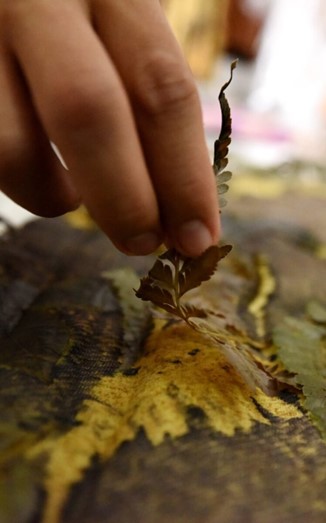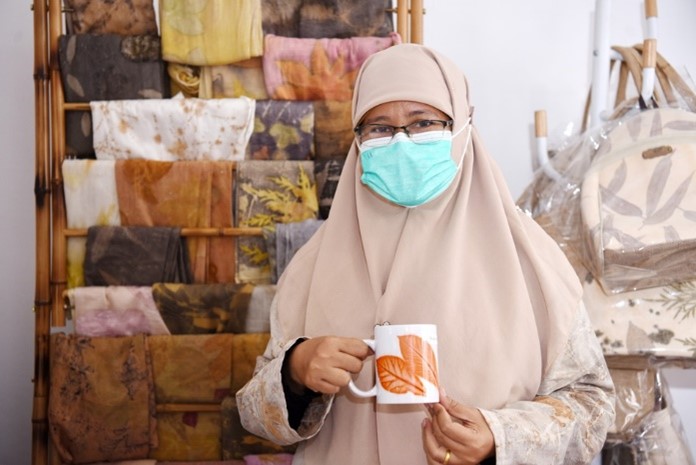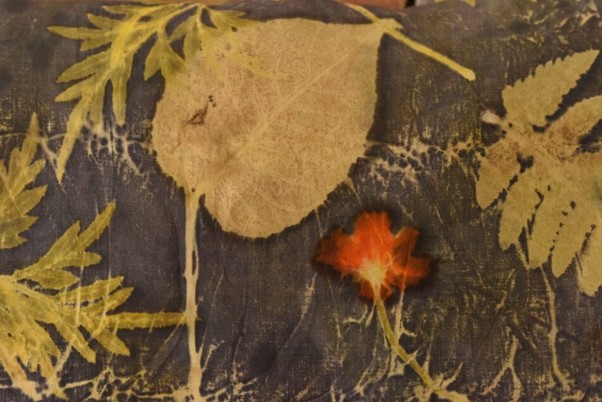Editorial Team
Published on 8 January 2024

 The eco-printing process begins with the search for raw materials. Sari prefers natural fibers over synthetic fabrics because their texture binds color more effectively. Once cleaned, the fabric enters the mordanting stage, which binds the dye and opens the fabric's pores for even coloring later on. Leaves or other plant parts used as motifs are applied to the fabric by tightly rolling them up within a layer of cloth. The roll of fabric is later steamed and then air dried for one to two weeks, avoiding direct sunlight to prevent damage to the applied motifs and coloring.
Sari used various plants and parts with attractive colors and motifs for her eco-printing products, such as teak, sappanwood, and gambier. She promotes the sustainability aspect of the business; the manufacturer uses minimal waste and low chemical usage and helps improve the community's economy as the process can be carried out in household industries. Abundant raw materials make it easy for communities to develop Eco-printing.
The eco-printing process begins with the search for raw materials. Sari prefers natural fibers over synthetic fabrics because their texture binds color more effectively. Once cleaned, the fabric enters the mordanting stage, which binds the dye and opens the fabric's pores for even coloring later on. Leaves or other plant parts used as motifs are applied to the fabric by tightly rolling them up within a layer of cloth. The roll of fabric is later steamed and then air dried for one to two weeks, avoiding direct sunlight to prevent damage to the applied motifs and coloring.
Sari used various plants and parts with attractive colors and motifs for her eco-printing products, such as teak, sappanwood, and gambier. She promotes the sustainability aspect of the business; the manufacturer uses minimal waste and low chemical usage and helps improve the community's economy as the process can be carried out in household industries. Abundant raw materials make it easy for communities to develop Eco-printing.
 Along with her colleagues Arif Nuryawan, S.Hut, M.Si, Ph.D, the Chair of the USU Faculty of Forestry's Department of Forest Product Technology, and Dr. Bejo Slamet, S.Hut, M.Si, Sari has promoted her eco-print idea through a series of community service activities in Pangkalan Susu and Lubuk Kertang in the Langkat Regency, as well as Sei Glugur in Deli Serdang Regency. She and her team encourage the communities in these rural areas to explore the rich natural resources that can be repurposed fruitfully for a green economy.
With her team, Sari herself has also established an eco-print business unit called Nauli Eco-print. The unit has conducted numerous eco-print training sessions for interested communities, most recently for refugees under the UN-based International Organization for Migration (IOM. Somalia, Sri Lanka, and Afghanistan refugees were trained to produce Eco-print products from June 21 to 25, 2021.
Sari is determined to pursue further research in forest product utilization for eco-print by continually testing various plants that could be used as raw materials for eco-print manufacturing. She believes her efforts can contribute to Sustainable Development Goals by educating society on the potential of environmentally friendly ventures for livelihood and communal creativity.
Along with her colleagues Arif Nuryawan, S.Hut, M.Si, Ph.D, the Chair of the USU Faculty of Forestry's Department of Forest Product Technology, and Dr. Bejo Slamet, S.Hut, M.Si, Sari has promoted her eco-print idea through a series of community service activities in Pangkalan Susu and Lubuk Kertang in the Langkat Regency, as well as Sei Glugur in Deli Serdang Regency. She and her team encourage the communities in these rural areas to explore the rich natural resources that can be repurposed fruitfully for a green economy.
With her team, Sari herself has also established an eco-print business unit called Nauli Eco-print. The unit has conducted numerous eco-print training sessions for interested communities, most recently for refugees under the UN-based International Organization for Migration (IOM. Somalia, Sri Lanka, and Afghanistan refugees were trained to produce Eco-print products from June 21 to 25, 2021.
Sari is determined to pursue further research in forest product utilization for eco-print by continually testing various plants that could be used as raw materials for eco-print manufacturing. She believes her efforts can contribute to Sustainable Development Goals by educating society on the potential of environmentally friendly ventures for livelihood and communal creativity.